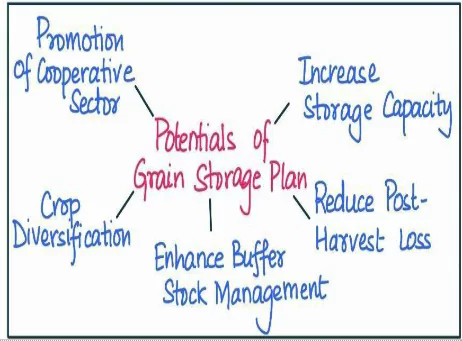Answer:
|
How to approach the question
- Introduction
- Write about ‘World’s Largest Grain Storage Plan in the Cooperative Sector’ briefly
- Body
- Write its potential to address India’s longstanding buffer stock challenges and ensure food security.
- Write various challenges and limitations which may hinder the effectiveness of this plan.
- Write suitable way ahead in this regard.
- Conclusion
- Give appropriate conclusion in this regard.
|
Introduction
The recently sanctioned ‘World’s Largest Grain Storage Plan in the Cooperative Sector’ aims to enhance India’s grain storage capacity from 145 to 215 million tonnes through a Rs 1 lakh crore investment. It plans to construct godowns at PACS level, promoting food security, reducing wastage, and empowering farmers.l
Body
Its potential to address India’s longstanding buffer stock challenges and ensure food security
- Increased Storage Capacity: Boosting the storage capacity from 145 million to 215 million tonnes can significantly alleviate storage constraints that have historically led to grain surplus wastage, like the excessive grain surplus of 2020 which, due to lack of adequate storage, led to spoilage.
 Reduced Post-Harvest Losses: India loses around $14 billion annually due to its post-harvest losses. Modern storage infrastructure such as silos ensures optimal storage conditions, reducing post-harvest losses from pests, diseases, and environmental factors. Eg: the USA, where the use of silos has resulted in significant reductions in grain spoilage.
Reduced Post-Harvest Losses: India loses around $14 billion annually due to its post-harvest losses. Modern storage infrastructure such as silos ensures optimal storage conditions, reducing post-harvest losses from pests, diseases, and environmental factors. Eg: the USA, where the use of silos has resulted in significant reductions in grain spoilage.- Enhanced Buffer Stock Management: As by improving storage capacity, it can ensure grain availability during times of adversity. To prevent situations similar to the 2009 drought in India, where the shortage of a well-managed buffer stock led to severe supply issues.
- Crop Diversification: With assured storage facilities, farmers can be encouraged to diversify crop production, similar to how some farmers in Punjab shifted from paddy to maize and soybean. This can lead to enhanced nutritional security and can also improve farmers’ income potential.
- Promotion of Cooperative Sector: By involving Primary Agricultural Credit Societies (PACS) in the storage infrastructure, the plan can strengthen the cooperative sector. This decentralized approach to grain storage could mirror the success of the Amul cooperative model in the dairy sector.
Various challenges and limitations which may hinder the effectiveness of this plan
- Funding: The initiative needs a significant investment, and securing continuous and transparent funding might pose a challenge. It may mirror issues faced by similar ambitious projects, such as the Pradhan Mantri Krishi Sinchayee Yojana, where funding has been a concern.
- Infrastructure: The construction of silos requires supporting infrastructure like roads and electricity. Rural areas, which need these facilities the most, often lack such infrastructure, as seen in many parts of Bihar and Uttar Pradesh.
- Maintenance: Storage facilities require consistent upkeep. Without regular maintenance, they could deteriorate rapidly, leading to inefficiency, as witnessed in some Food Corporation of India storage facilities.
- Climate Change: The impact of climate change on these facilities can’t be ignored. Increased flooding, like in Kerala in 2018, could damage infrastructure and affect the quality of stored grain.
- Coordination between Agencies: The implementation involves multiple stakeholders, like PACS, state governments, and central government agencies. Thus, any bureaucratic inefficiency could slow down the process, as seen in the implementation of some centrally- sponsored schemes.
Suitable way ahead in this regard
- Funding Assurance: Secure and sustained funding should be ensured through dedicated financial plans. Government backing and potential private partnerships, akin to the public-private partnership model in the Smart Cities Mission, could be explored.
- Infrastructure Development: The plan should be synchronised with existing rural development schemes like Pradhan Mantri Gram Sadak Yojana for road construction and Saubhagya scheme for electricity, ensuring comprehensive infrastructure development.
- Technology Integration: Integrating technology, like IoT devices for real-time monitoring, can enhance the efficiency of the storage facilities. Digital Green’s work in leveraging technology for agriculture can serve as an inspiration.
- Efficient Coordination: A central coordination committee should be established to ensure smooth communication between various stakeholders. Similar approaches have worked in the coordination of multi-sectoral initiatives like the National Nutrition Mission.
- Change Management: A significant effort should be made to build awareness and trust among farmers and cooperatives about the benefits of modern storage facilities. The successful adoption of Bt cotton in India serves as a positive example of change management in agriculture.
Conclusion
Overall, while the ‘World’s Largest Grain Storage Plan in the Cooperative Sector’ is a significant step towards addressing India’s buffer stock and food security challenges, its effective implementation will require a concerted effort that acknowledges and addresses potential obstacles. By doing so, this plan could transform the face of India’s agricultural sector.
To get PDF version, Please click on "Print PDF" button.
 Reduced Post-Harvest Losses: India loses around $14 billion annually due to its post-harvest losses. Modern storage infrastructure such as silos ensures optimal storage conditions, reducing post-harvest losses from pests, diseases, and environmental factors. Eg: the USA, where the use of silos has resulted in significant reductions in grain spoilage.
Reduced Post-Harvest Losses: India loses around $14 billion annually due to its post-harvest losses. Modern storage infrastructure such as silos ensures optimal storage conditions, reducing post-harvest losses from pests, diseases, and environmental factors. Eg: the USA, where the use of silos has resulted in significant reductions in grain spoilage.
Latest Comments